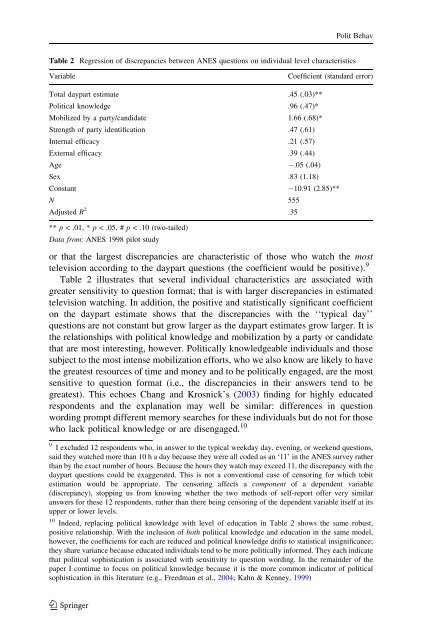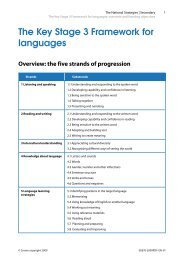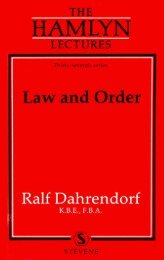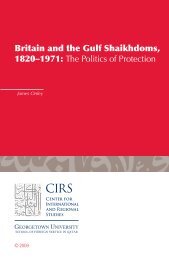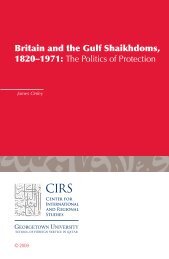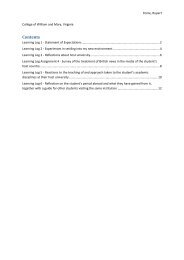Polit BehavTable 2 Regression <strong>of</strong> discrepancies between ANES questions on <strong>in</strong>dividual level characteristicsVariableCoefficient (standard error)Total daypart estimate .45 (.03)**<strong>Political</strong> knowledge .96 (.47)*Mobilized by a party/candidate 1.66 (.68)*Strength <strong>of</strong> party identification .47 (.61)Internal efficacy .21 (.57)External efficacy .39 (.44)Age .05 (.04)Sex .83 (1.18)Constant 10.91 (2.85)**N 555Adjusted R 2 .35** p < .01, * p < .05, # p < .10 (two-tailed)Data from: ANES 1998 pilot studyor that the largest discrepancies are characteristic <strong>of</strong> those who watch the mosttelevision accord<strong>in</strong>g <strong>to</strong> the daypart questions (the coefficient would be positive). 9Table 2 illustrates that several <strong>in</strong>dividual characteristics are associated withgreater sensitivity <strong>to</strong> question format; that is with larger discrepancies <strong>in</strong> estimatedtelevision watch<strong>in</strong>g. In addition, the positive and statistically significant coefficien<strong>to</strong>n the daypart estimate shows that the discrepancies with the ‘‘typical day’’questions are not constant but grow larger as the daypart estimates grow larger. It isthe relationships with political knowledge and mobilization by a party or candidatethat are most <strong>in</strong>terest<strong>in</strong>g, however. <strong>Political</strong>ly knowledgeable <strong>in</strong>dividuals and thosesubject <strong>to</strong> the most <strong>in</strong>tense mobilization efforts, who we also know are likely <strong>to</strong> havethe greatest resources <strong>of</strong> time and money and <strong>to</strong> be politically engaged, are the mostsensitive <strong>to</strong> question format (i.e., the discrepancies <strong>in</strong> their answers tend <strong>to</strong> begreatest). This echoes Chang and Krosnick’s (2003) f<strong>in</strong>d<strong>in</strong>g for highly educatedrespondents and the explanation may well be similar: differences <strong>in</strong> questionword<strong>in</strong>g prompt different memory searches for these <strong>in</strong>dividuals but do not for thosewho lack political knowledge or are disengaged. 109 I excluded 12 respondents who, <strong>in</strong> answer <strong>to</strong> the typical weekday day, even<strong>in</strong>g, or weekend questions,said they watched more than 10 h a day because they were all coded as an ‘11’ <strong>in</strong> the ANES survey ratherthan by the exact number <strong>of</strong> hours. Because the hours they watch may exceed 11, the discrepancy with thedaypart questions could be exaggerated. This is not a conventional case <strong>of</strong> censor<strong>in</strong>g for which <strong>to</strong>bitestimation would be appropriate. The censor<strong>in</strong>g affects a component <strong>of</strong> a dependent variable(discrepancy), s<strong>to</strong>pp<strong>in</strong>g us from know<strong>in</strong>g whether the two methods <strong>of</strong> self-report <strong>of</strong>fer very similaranswers for these 12 respondents, rather than there be<strong>in</strong>g censor<strong>in</strong>g <strong>of</strong> the dependent variable itself at itsupper or lower levels.10 Indeed, replac<strong>in</strong>g political knowledge with level <strong>of</strong> education <strong>in</strong> Table 2 shows the same robust,positive relationship. With the <strong>in</strong>clusion <strong>of</strong> both political knowledge and education <strong>in</strong> the same model,however, the coefficients for each are reduced and political knowledge drifts <strong>to</strong> statistical <strong>in</strong>significance;they share variance because educated <strong>in</strong>dividuals tend <strong>to</strong> be more politically <strong>in</strong>formed. They each <strong>in</strong>dicatethat political sophistication is associated with sensitivity <strong>to</strong> question word<strong>in</strong>g. In the rema<strong>in</strong>der <strong>of</strong> thepaper I cont<strong>in</strong>ue <strong>to</strong> focus on political knowledge because it is the more common <strong>in</strong>dica<strong>to</strong>r <strong>of</strong> politicalsophistication <strong>in</strong> this literature (e.g., Freedman et al., 2004; Kahn & Kenney, 1999)123
Polit BehavMore importantly, however, these nonrandom discrepancies are greatest amongprecisely those <strong>in</strong>dividuals most <strong>in</strong>terested <strong>in</strong> campaigns, most likely <strong>to</strong> vote, and soon. The daypart questions <strong>in</strong>flate estimates <strong>of</strong> television watch<strong>in</strong>g generally, butbecause discrepancies with other measures are systematically more pronouncedamong these <strong>in</strong>dividuals the relationships between, for example, political knowledge,exposure <strong>to</strong> negative advertis<strong>in</strong>g, and attitudes and behavior will be sensitive<strong>to</strong> the questions used <strong>to</strong> construct the exposure estimates, vary<strong>in</strong>g <strong>in</strong> sign and size(Berry and Feldman 1985). As implied by this evidence, the literature us<strong>in</strong>g CMAGdata has been <strong>in</strong>consistent, suggest<strong>in</strong>g both that the least politically knowledgeableare unaffected or confused by exposure <strong>to</strong> (negative) advertis<strong>in</strong>g (Stevens, 2005)and that they benefit the most from exposure <strong>to</strong> advertis<strong>in</strong>g (Freedman et al., 2004).In either case the normative implications are pr<strong>of</strong>ound, either imply<strong>in</strong>g that, all elseequal, the modern campaign exacerbates cynicism and <strong>in</strong>equality <strong>in</strong> politicalparticipation or that campaign ads ‘‘represent the multivitam<strong>in</strong>s <strong>of</strong> Americanpolitics’’ (Freedman et al., 2004, 725).The 1998 ANES pilot data allow a more explicit analysis <strong>of</strong> how questionformats may contribute <strong>to</strong> the confusion. I estimated identical models <strong>of</strong> therelationship between exposure <strong>to</strong> negative advertis<strong>in</strong>g, political knowledge and fourdependent variables typical <strong>of</strong> the literature: engagement with the campaign(frequency <strong>of</strong> discuss<strong>in</strong>g politics dur<strong>in</strong>g the past week and awareness <strong>of</strong> the issuesthe candidates for governor had been discuss<strong>in</strong>g dur<strong>in</strong>g the campaign), views <strong>of</strong>government (external efficacy), and the probability <strong>of</strong> vot<strong>in</strong>g (see Appendix fordetails). 11 One set <strong>of</strong> models operationalized <strong>to</strong>tal exposure <strong>to</strong> negative advertis<strong>in</strong>gus<strong>in</strong>g the daypart method, another calculated <strong>to</strong>tal exposure from the ‘‘typical day’’questions, while a third constructed <strong>to</strong>tal exposure us<strong>in</strong>g the shows method. Inaddition I controlled for standard variables <strong>in</strong> the literature (e.g., Freedman et al.,2004): the <strong>to</strong>tal amount <strong>of</strong> negative advertis<strong>in</strong>g <strong>in</strong> the respondent’s market—ameasure <strong>of</strong> how <strong>in</strong>tense the campaign was <strong>in</strong> that locale 12 —dummy variables fortwo <strong>of</strong> the three states (Georgia and Ill<strong>in</strong>ois), strength <strong>of</strong> party identification, theextent <strong>of</strong> mobilization from the parties, education, race, age, and <strong>in</strong>come. The keyvariables <strong>of</strong> <strong>in</strong>terest are exposure <strong>to</strong> negative advertis<strong>in</strong>g and the <strong>in</strong>teraction betweenexposure <strong>to</strong> negative advertis<strong>in</strong>g and political knowledge. Table 3 presents the11 The CMAG data for 1998 do not <strong>in</strong>clude <strong>in</strong>formation about guberna<strong>to</strong>rial advertis<strong>in</strong>g. However,Stevens (2005) argues that because both the guberna<strong>to</strong>rial and Senate elections <strong>in</strong> California, Georgia,and Ill<strong>in</strong>ois shared similar characteristics, such as competitiveness, and because candidates tend <strong>to</strong> air adsat the same time it is a reasonable assumption that exposure <strong>to</strong> advertis<strong>in</strong>g <strong>in</strong> the guberna<strong>to</strong>rial race washighly correlated with exposure <strong>to</strong> the Senate race. In Tables 3 and 4 I <strong>in</strong>clude one dependent variable thatis specific <strong>to</strong> the guberna<strong>to</strong>rial races <strong>in</strong> these states, the number <strong>of</strong> issues that respondents recognize thecandidates have talked about: if exposure <strong>to</strong> negative advertis<strong>in</strong>g <strong>in</strong>creases awareness <strong>of</strong> issues and<strong>in</strong>dividuals who saw a lot <strong>of</strong> Senate ads also saw a lot <strong>of</strong> guberna<strong>to</strong>rial ads we would expect exposure <strong>to</strong>negative advertis<strong>in</strong>g <strong>to</strong> have a positive relationship with recognition <strong>of</strong> issues.12 Total negative advertis<strong>in</strong>g <strong>in</strong> a television market is arguably a better measure <strong>of</strong> campaign <strong>in</strong>tensitythan <strong>to</strong>tal advertis<strong>in</strong>g because we tend <strong>to</strong> see more advertis<strong>in</strong>g, and more negative advertis<strong>in</strong>g, <strong>in</strong>competitive races. I also estimated all the models <strong>in</strong> Tables 3 and 4 with <strong>to</strong>tal advertis<strong>in</strong>g as a proxy forcampaign <strong>in</strong>tensity. It made no difference <strong>to</strong> the results.123


